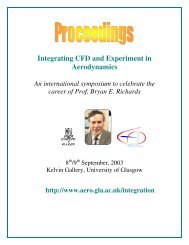Matlab code for damping identification using energy ... - CFD4Aircraft
Matlab code for damping identification using energy ... - CFD4Aircraft
Matlab code for damping identification using energy ... - CFD4Aircraft
Create successful ePaper yourself
Turn your PDF publications into a flip-book with our unique Google optimized e-Paper software.
under study. Starting from eq. (4), in the case of viscous <strong>damping</strong> and considering the initial<br />
instant t=0, it becomes<br />
∫ T<br />
∫ T<br />
ẋ T Cẋ dt = ẋ T g(t) dt (5)<br />
0<br />
0<br />
where C is the viscous <strong>damping</strong> matrix, which can be written as<br />
C =<br />
p∑<br />
c i L i (6)<br />
i=1<br />
where L i ∈ R n×n is a matrix which indicates the location of the i th of p different viscous<br />
<strong>damping</strong> sources of amplitude c i .<br />
Figure 1: Absolute dashpot connecting DOF 2 to the ground<br />
In the case of an absolute dashpot connecting one degree of freedom (e.g. degree-of-freedom<br />
2, see figure 1) of the structure to the ground, L i takes the <strong>for</strong>m<br />
⎛<br />
⎞<br />
0 0 0 ··· 0<br />
0 1 0 ··· 0<br />
L i =<br />
0 0 0 ··· 0<br />
⎜<br />
⎝<br />
.<br />
. . . ..<br />
⎟<br />
0 ⎠<br />
0 0 0 0 0<br />
(7)<br />
Figure 2: Relative dashpot connecting DOF 1 to DOF 2<br />
In this case the pattern approach does not help the reduction of the number of unknowns,<br />
but helps a systematic procedure to define the <strong>damping</strong> sources in an automated way.<br />
2
















